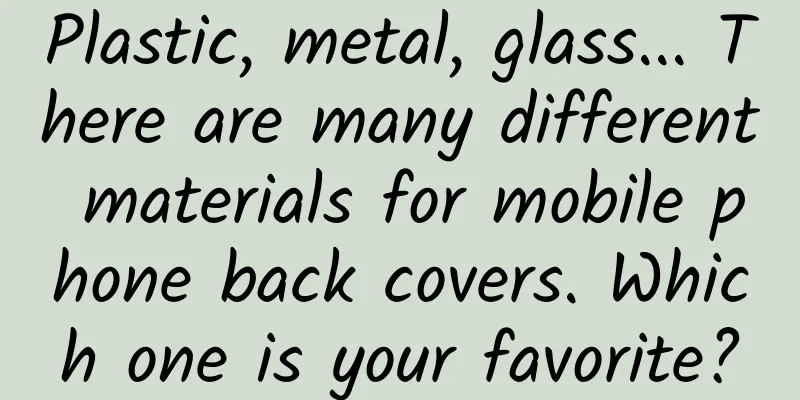Plastic, metal, glass... There are many different materials for mobile phone back covers. Which one is your favorite?

|
How did glass become the mainstream material for smartphone back covers? There are so many materials for smartphone back covers, which one do you prefer? 01 Colorful plastic body polycarbonateBefore 2015, plastic was the most common material for mobile phone back covers. There are many types of plastic materials, and the cost is relatively low. It was widely used in the early development of feature phones and smartphones. Many netizens think that plastic is synonymous with cheapness, but this is not the case. Some brands even still use plastic back covers on their flagship phones.
Plastic back shells are not necessarily low-grade and cheap. There are many kinds of plastics, such as PP polypropylene, PE polyethylene, PVC polyvinyl chloride and PC polycarbonate, etc., which are collectively referred to as plastics. Among them, PC polycarbonate is the most common mobile phone plastic shell material. Polycarbonate is heat-resistant, not easy to deform, has weak signal interference, and is easier to dye. Of course, its disadvantages are also obvious, and its hardness is not high enough. Polycarbonate can be said to be the leader among industrial plastic materials. Many mobile phone brands have used it to make the back cover of the body, such as Nokia's Lumia series. We all know that Nokia's mobile phones are very resistant to falling. A big reason for this is the plastic body used in it. Due to the strong impact resistance of plastic, it can remain safe even if it is hit by a fall. In addition, since it is easier to color, it can create a more colorful body. In 2013, Apple launched its first model with richer colors, the iPhone 5c. It can be said that by making good use of polycarbonate plastic, mobile phones can also be made to look high-end. 02 The forging history of a steel plateMetalIn 2014, Apple released the iPhone 6 series with aviation-grade aluminum alloy body. Metal body mobile phones began to quickly gain popularity and gradually became the standard configuration of smartphones in the eyes of users. Metal materials themselves have excellent texture and have been the mainstream for quite a long time. The two most widely used metals are "aviation-grade aluminum alloy" and "304 austenitic stainless steel". Apple has used aluminum alloy in many generations of products since iPhone 5, which has made the phone thinner and lighter. At the same time, the influence of iPhone has further promoted the popularity of metal back covers. Stainless steel is often used in mobile phone frames. The most typical example in history is Xiaomi 4, which is made of austenitic 304 stainless steel. "An artistic journey on a piece of steel plate" has become its best synonym. The biggest advantage of metal is good heat dissipation, while the biggest disadvantage is that it will shield electromagnetic signals. Apple iPhone 6 used the "white belt" design to solve the antenna design problem. In contrast, glass has better signal conductivity, and the integrated appearance design is easier to handle than metal. In addition, glass makes it possible for mobile phones to be charged wirelessly. In the mainstream market, we almost never see models with metal back covers. 03 From gradient colors to exquisite glass with AG technologyAt present, the most common back cover of mobile phones in the mobile phone market is glass. In 2010, Apple's iPhone 4, which uses a double-sided glass design, was launched. It changed the bloated design of mobile phones and took the exquisiteness of glass to a new height. Unlike plastic and metal, glass can reflect some light and show different luster when viewed from different angles, so glass products in daily life always give people a sense of refinement. The glass back cover has no interference with the mobile phone signal and the magnetic field of wireless charging. At the same time, mobile phone manufacturers use coating methods to make the color and pattern of the mobile phone back cover more diverse, meeting the personalized needs of users. For example, in 2019, the Huawei P30 series was released. The phone upgraded the glass back cover technology and brought a new gradient color design - Sky Realm, which attracted various manufacturers to imitate and led the trend for a while. In addition to playing with color matching, mobile phone manufacturers are also very concerned about the curved cutting of the glass back cover, micro-curved design, 3D curved glass, etc. In addition, in order to further improve the grip feel, anti-fingerprint AG glass technology is increasingly favored by manufacturers. AG glass, also known as anti-reflective glass and anti-glare glass, is made through a special chemical process. Its characteristic is that it changes the original glass reflective surface into a matte diffuse reflective surface. It can blur the reflection, prevent glare, reduce the reflectivity, and reduce light and shadow. At the same time, the uneven fine particles on the surface also create a delicate feel. There are currently three main AG glass processes: spraying, coating and chemical etching. Not long ago, OnePlus 9 Pro released the Oasis color version, which uses an exclusive double-layer AG process, with high-fog AG glass superimposed on a diffuse reflective AG film, making the overall visual effect softer, the touch warmer and less likely to stick to fingerprints. ConclusionIn addition to the above mainstream materials, there are also leather, which represents a luxurious quality, and ceramic, which is second only to sapphire in Mohs hardness and has the characteristics of wear resistance and scratch resistance. From plastic, metal to glass, mobile phone manufacturers have never stopped exploring the materials of the back cover of the body, but from the current point of view, glass material will still be the mainstream for some time to come. I believe that with the development of new material technology, the material of the back cover of mobile phones will usher in new changes. We might as well look forward to it. Which material of the back cover of mobile phones do you prefer? You are also welcome to leave a message in the comment area. Of course, if you feel that the article is helpful to you, you can triple-click it with one click. Your support is the greatest encouragement to the author. |
>>: WeChat adds "Rush" status: based on Kris Wu
Recommend
In the fierce battle of AI, which BAT can overtake others?
After nearly 20 years of development, the three l...
The latest research determines the best time to fall asleep! Going to bed too early or too late has health risks...
Everyone is familiar with the dangers of staying ...
Plastic bags can also be thrown into the recycling bin. Is that city friendly?
Have you ever paid attention to the plastics you ...
Fish don't have hands, so what do they do when they feel itchy? | Nature Trumpet
Welcome to the 20th issue of the Nature Trumpet c...
Mango TV is unique and independent, and it is more than just a single broadcaster
The fierce competition in the video website indust...
Ps+Ai double major! The first compulsory course for designers
Ps+Ai double major! The first compulsory course f...
Is the "light vaccine" used by the Chinese Olympic delegation the ultimate weapon against the new coronavirus?
Koko, have you heard of "light vaccine"...
An event planning and execution plan!
There are many steps from planning to completion ...
Plague and the Evolution of Diet: The Three Years of the Black Death in Europe
Written by | Wei Shuihua Header Image | foodiesfe...
Here is everything you want to know about cheating!
APP ranking terms Ranking manipulation: refers to...
Apple plans to establish a new supply chain in the country: exclusively for iPhones in the Chinese market
DigiTimes released a report today highlighting th...
Can donkey-hide gelatin cure cancer? The health supplements you think have magical effects may not be very effective
Are expensive vitamins better than cheap ones? Ca...
The symptoms are similar, be careful that a cold may develop into myocarditis!
Review expert: Peng Guoqiu, deputy chief physicia...
White is not the base color of the earth!
As my country's urbanization and modernizatio...
The most popular ceiling effect implementation on Android (Part 1)
I began to appreciate the beauty of ItemDecoratio...









